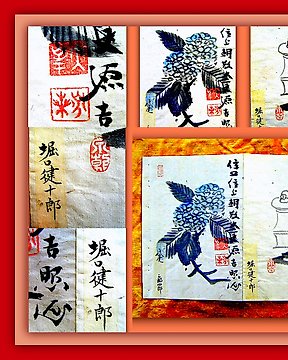
Matsuo Bashō 松尾 芭蕉 - Signatur, Haiku-Dichtung mit Haiga-Malerei, Tōkaidō, 奥の細道 „Der enge Pfad zum tiefen Norden" - 1670
Nr. 83542353

Nr. 83542353

Original Japanese Carving & Manuscript
Erotic, Japan, Shunga
Y.Shigenobu, around 1700-1750
*** Masterpiece ***
Hand carved on a cattle bone
Erotic depiction of a Japanese-Lovers
Engraved colored with black ink
Size: 10,5cm x 3,3cm
hand-crafted by a Japanese artist Y.Shigenobu
Yanagawa Shigenobu was a Japanese painter in the ukiyo-e style.
He was active in Edo from the Bunka period onward.
In Edo, he resided in Honjo Yanagawa-chō district.
He was first the pupil, then son-in-law, and finally adopted son of the Edo master printmaker Katsushika Hokusai.
He designed illustrated books, prints, and surimono.
In Osaka, he worked with the gifted block cutter and printer Tani Seikō.
Shigenobu focused on theatrical subjects, but some of his best work in Osaka includes a series of deluxe ōban prints depicting geisha in the Shinmachi Nerimono parade in Osaka,
and approximately 30 fine surimono on various subjects (at least 18 in collaboration
with the Tsuru-ren Crane Group of kyōka poets), with blocks cut and printed by Seikō.
His pupils included Kuninao;
Shigeharu; Yanagawa Nobusada (Yokinobu); Shigemasa; Shigemitsu.
Shunga is a Japanese term for erotic art.
Most shunga are a type of ukiyo-e, usually executed in woodblock print format.
While rare, there are extant erotic painted handscrolls which predate the Ukiyo-e movement.Translated literally,
the Japanese word shunga means picture of spring; "spring" is a common euphemism for sex.
The ukiyo-e movement as a whole sought to express an idealisation of contemporary urban life and appeal to the new chōnin class.
Following the aesthetics of everyday life, Edo period shunga varied widely in its depictions of sexuality.
As a subset of ukiyo-e it was enjoyed by all social groups in the Edo period, despite being out of favour with the shogunate.
Almost all ukiyo-e artists made shunga at some point in their careers, and it did not detract from their prestige as artists.
Classifying shunga as a kind of medieval pornography can be misleading in this respect.
Shunga images and engravings on bone are very rare, as most have been destroyed
Cum să cumperi de la Catawiki
1. Descoperă ceva special
2. Plasează cea mai mare ofertă
3. Fă o plată sigură